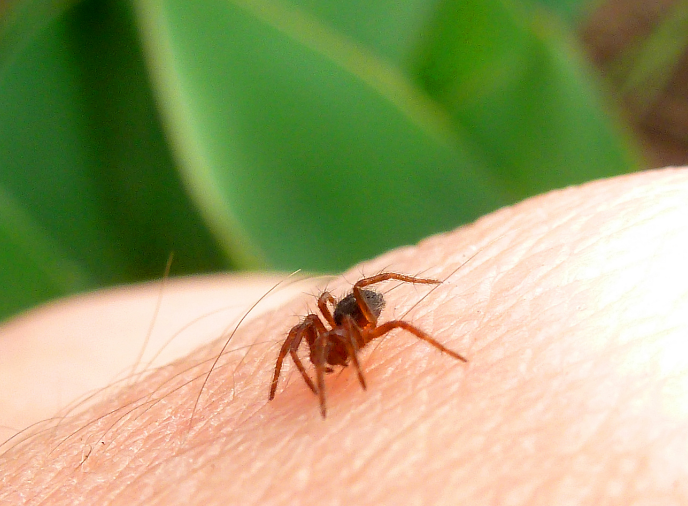In this article we will guide everything you need to know about Management of Spider Bite. We’ll answer the questions about symptoms, treatments, and prevention. By the end, you’ll have a comprehensive understanding of how to treat spider bites naturally or with medical interventions, what to avoid, and when to seek help.
Spider bites can be alarming, especially if you’re not sure whether it’s harmful or not. The majority of spider bites are benign and very slightly uncomfortable. However, certain species, like the black widow or brown recluse, can deliver venomous bites that require medical attention. Knowing how to handle a spider bite is essential for avoiding complications, especially if infection sets in.
When to Worry About a Spider Bite?

Not all spider bites require medical attention. However, there are several key indicators that you should not ignore:
- Increasing pain and swelling: If the bite area becomes larger, more painful, or is accompanied by throbbing, it could indicate venom spread or infection.
- Red streaks or pus: These are signs of infection. If red lines spread outward from the bite, it’s important to seek medical care.
- Muscle cramps or spasms: If you experience muscle pain or spasms, particularly in your abdomen or chest, it could suggest a venomous spider bite, like that of a black widow.
- Fever or chills: These systemic symptoms suggest a more serious reaction or an infection that needs medical evaluation.
- Blistering or ulceration: Certain venomous spiders, like the brown recluse, can cause tissue damage. If the bite site develops an ulcer or the skin starts to die, medical intervention is necessary.
- Neurological symptoms: If you experience dizziness, difficulty breathing, or an altered mental state, it could be an emergency, requiring immediate care.
If you experience any of these symptoms after a spider bite, it’s wise to visit a healthcare provider for assessment.
What Is the Best Antibiotic Management of Spider Bite?
Spider bites themselves are rarely treated with antibiotics unless they become infected. When there’s a secondary bacterial infection at the bite site, antibiotics may be prescribed. The most commonly used antibiotics include:
- Cephalexin (Keflex): This is often the first choice for skin infections caused by spider bites. It is effective against common bacteria like Staphylococcus and Streptococcus species.
- Clindamycin: This is another option for treating skin infections, especially if there’s concern for antibiotic-resistant bacteria like MRSA (methicillin-resistant Staphylococcus aureus).
- Doxycycline: This antibiotic is useful in treating infections caused by spider bites and can also treat infections from tick-borne bacteria, which may sometimes be mistaken for spider bites.
Remember that antibiotics should only be used under the direction of a healthcare provider.
How to Draw Poison Out of a Spider Bite?
While there are many traditional remedies for drawing out venom, the truth is that once venom is injected, it’s challenging to remove it. However, you can take steps to reduce its impact:
- Clean the wound: Wash the bite site with soap and water to minimize the risk of infection.
- Apply a cold compress: This can help reduce swelling and slow the spread of venom in mild cases.
- Elevate the bite area: If the bite is on a limb, raising it above heart level can decrease swelling and inflammation.
- Activated charcoal poultice: Some people use activated charcoal poultices to try to draw out toxins, although there’s little scientific evidence to support this.
In cases of venomous bites (like those from a black widow or brown recluse), it is critical to seek medical help rather than relying solely on home remedies.
Management of Spider Bite Infection Treatment
If a spider bite becomes infected, proper care is essential to avoid complications such as abscesses or cellulitis. Treatment may include:
- Antibiotics: As mentioned, cephalexin, doxycycline, or clindamycin are common choices for treating spider bite infections.
- Cleaning and draining: If the bite area becomes pus-filled, a doctor may need to drain it.
- Topical treatments: Using antibiotic ointments like Neosporin can help prevent infection in the early stages.
Management of Spider Bite Symptoms

The symptoms of a spider bite vary depending on the species and your body’s reaction. Common symptoms include:
- Redness and swelling: The bite site often becomes red, swollen, and itchy.
- Pain: While many spider bites are painless at first, they may become painful later on.
- Itching: Itchiness around the bite site is common and can last for several days.
- Blisters or necrosis: Venomous spiders may cause blistering, ulceration, or tissue necrosis at the site of the bite.
More serious bites, like those from black widows or brown recluse spiders, may lead to:
- Muscle cramps
- Fever
- Nausea and vomiting
- Difficulty breathing
- Fatigue or weakness
What Can Be Mistaken for a Spider Bite?
Many skin conditions can mimic the appearance of a spider bite, including:
- Staph infections (MRSA): These can appear as painful, red bumps that may be mistaken for spider bites.
- Tick bites: Certain tick bites, such as those from the deer tick, can cause a bullseye-like rash similar to a spider bite.
- Bed bug bites: Multiple itchy red welts caused by bed bugs can look like spider bites.
- Flea bites: Flea bites often appear in clusters, which could be confused with spider bites.
What is the Proper Management of Spider Bite?
Proper treatment for a spider bite includes:
- Cleaning the wound: Wash the bite area with soap and water to prevent infection.
- Applying a cold compress: This will reduce swelling and discomfort.
- Over-the-counter medications: Antihistamines can help relieve itching, while pain relievers like ibuprofen can manage pain and inflammation.
- Seeking medical care: If the bite shows signs of infection or if you suspect it’s from a venomous spider, consult a doctor.
What is the Antibiotic Choice for Spider Bites?

As discussed earlier, the preferred antibiotics for treating infected spider bites are cephalexin, doxycycline, and clindamycin. However, the decision will depend on the bacteria involved and your medical history.
What is the Injection for a Spider Bite?
If a spider bite is from a venomous species like a black widow, antivenom injections may be administered in severe cases. Antivenom works by neutralizing the venom’s effects and can help alleviate symptoms such as muscle pain, cramping, and difficulty breathing.
Management of Spider Bite First Aid

The redback spider, common in Australia, can deliver a painful bite that may lead to serious symptoms like sweating, muscle pain, and nausea. First aid management includes:
- Wash the bite area: thoroughly using soap and water
- Apply a cold compress: This can reduce pain and swelling.
- Seek medical help: Redback bites may require antivenom, especially if symptoms worsen.
- Avoid applying pressure immobilization: Unlike snake bites, pressure immobilization is not recommended for redback spider bites.
Best Ointment Management of Spider Bite
The best ointments for spider bites aim to reduce swelling, itching, and the risk of infection. Over-the-counter options include:
- Hydrocortisone cream: This can help relieve itching and inflammation.
- Neosporin or Polysporin: These topical antibiotics can help prevent or treat infection.
How to Treat a Spider Bite Naturally?
If you prefer natural remedies, some approaches may help alleviate mild symptoms of a spider bite:
- Aloe vera: Applying aloe vera gel can reduce inflammation and promote healing
- Baking soda paste: A paste made from baking soda and water may soothe itching and swelling.
- Turmeric: Known for its anti-inflammatory properties, turmeric can be applied as a paste to the bite area.
- Lavender essential oil: This oil may help relieve pain and reduce inflammation.
However, always monitor the bite site for signs of infection or worsening symptoms and consult a doctor if necessary.
First Aid Treatment for Insect Bites
Spider bites are a type of insect bite, and the first aid approach is similar to other insect bites:
- Clean the wound: To prevent infection, clean the area with soap and water.
- Apply a cold compress: This reduces swelling and discomfort.
- Take an antihistamine: If itching is severe, oral antihistamines like Benadryl can help.
- Monitor for allergic reactions: Seek emergency care if you experience symptoms like difficulty breathing, swelling of the face, or hives.
Two Signs and Symptoms of a Spider Bite
Two common signs of a spider bite are:
- Localized redness and swelling: The bite area may become red, swollen, and itchy.
- Pain: Some spider bites are painful, especially bites from venomous species.
Stages of a Spider Bite
A spider bite typically progresses through the following stages:
- Initial reaction: Redness, swelling, and itching begin shortly after the bite.
- Pain or discomfort: Depending on the spider, pain may increase over the next few hours.
- Blistering or necrosis (venomous bites): Bites from spiders like the brown recluse can lead to blistering or tissue death.
- Healing: Most bites heal within a few days, but severe reactions may take weeks or longer.
What Not to Do with a Spider Bite?
To avoid making a spider bite worse, avoid the following:
Scratching: Scratching the bite might make an infection more likely.

Applying heat: Heat can worsen venom spread in the case of venomous bites.
Ignoring symptoms: If you experience worsening symptoms, don’t delay seeking medical care.
Conclusion
The management of spider bites involves recognizing symptoms, using first aid techniques, and seeking medical attention when necessary. Knowing when to worry and how to treat a spider bite properly can prevent complications and ensure a quicker recovery. For more information visit our website.



